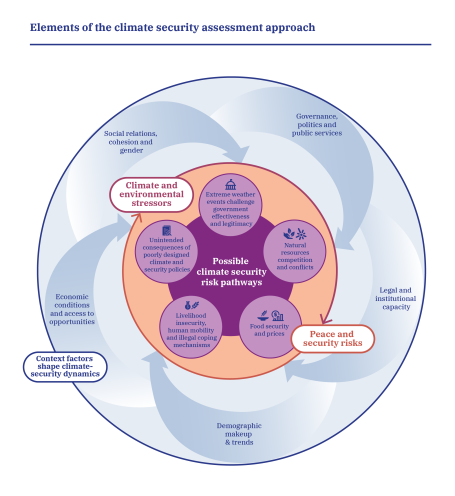Methodology
Climate security risk methodology overview
Climate change and environmental challenges reverse progress towards sustainable development and peace, posing risks to human security and making peace harder to achieve. Both slow onset changes such as temperature rise, ocean acidification and changes in precipitation patterns, as well as fast onset events such as storms and floods can have an effect on economic and political security, and on the security of a particular community’s food, health and environment.
Policy- and decision-makers in multiple sectors, especially development, diplomacy and defence, have sought ways to predict and respond to these impacts. However, in order to do so effectively and sustainably, the complexity of different factors and interactions has to be unpacked into a granular understanding of the relationship between environmental change and insecurity in a given context. For awareness of the risks to be converted into action that improves lives, concrete entry points need to be identified.
This is where the Weathering Risk methodology comes in.

Developed by adelphi and the Potsdam Institute for Climate Impact Research and supported by partners such as Chatham House, CGIAR, The Economist Intelligence Unit, Institute for Security Studies, Igarapé Institute, UNDP, UNEP, United Nations University and The World Bank, the Weathering Risk methodology provides a framework for our own assessments, while also offering others a flexible toolkit that can be applied across different scales and degrees of complexity.
Based on two years of field testing through over twelve Weathering Risk assessments on the ground from the Pacific to the Levant, this guidance document has been adapted the original approach to make it easier, replicable and usable. Elements of the climate security assessment approach include:
- Context factors shaping vulnerability and resilience
Context factors shaping vulnerability and resilience to climate and security risks, including a variety of cross-cutting topics like gender equality and social inclusion. These context factors normally play a decisive role in all pathways and should be at the centre of the analysis.
- Climate and environmental stressors
Climate changes, environmental challenges and their direct impacts, including temperature rise and its impacts on agriculture or flooding and its impact on infrastructure as well as other non-climate related environmental issues such as pollution.
- Peace and security context
Peace and security context, which comprise the history and state of economic, social and political (in)stability, past and ongoing security risks and conflict dynamics, the drivers and causes of insecurity, and the main actors that have an impact on security and stability.
- Climate-security risk pathways
The interactions between climate impacts, security and peace or climate-security risk pathways that link certain climatic impacts with specific security risks and conflicts; for example, how more pressure on natural resources such as land and water can increase competition and tensions over access and availability of these resources and show how security risks and conflicts effect resilience, the environment and climate risks; for example, how insecurity can contribute to increased environmental degradation which in turn can undermine the resilience of local communities.
Identification of Responses
The final aspect of the methodology focuses on identifying context-specific response measures and actions to address climate-related security risks. The focus should be on inclusive and integrated responses that build resilience against both climate and security risks and include a special focus on ‘no regret options’ in the face of uncertainty and shifting probabilities of climate-related hazards and future socio-political developments. Although there is no universal set of activities that simultaneously provides adaptation to climate change and environmental challenges, peacebuilding, and development benefits, evidence and lessons learned from past climate-security programming can help inform responses.
Scenarios - Looking Forward
Climate-security risk assessments are often future oriented as climate impacts and pressures are set to change significantly in the future. Thus, one key approach to deal with this uncertainty and think about future risks is scenario development or planning. The basis of any scenario development is to identify key trends and critical factors that – judging from the status quo – will have a decisive influence in the future. The greater their influence on the subject being investigated and the higher the degree of uncertainty in how they will develop, the more important they are in scenario development. Based on the different pathways and interactions between these key drivers, a number of coherent and plausible narrative scenarios are developed to test responses.
Monitoring and Evaluation
The last part of the guidance introduces monitoring and evaluation of climate-security interventions (M&E). As with any other intervention, a clear theory of change is not only key for implementation, but also for effective M&E. In addition to a clear theory of change, indicators are the second building block for effective M&E. Responses to climate-security risks and the resilience they build are multidimensional, and therefore require adequate indicators to track progress across different dimensions within an interactive system.
Our approach is openly accessible, free to use and replicable. Selected tools, dashboards, variables, and indicators to inform climate-security assessments are available as a separate download here.
Learn more about how qualitative research can uncover hidden drivers and connectors and generate contextualised and actionable knowledge and the importance of combining qualitative and quantitative approaches in our op-ed The power of real-world qualitative assessments for addressing climate and environmental security risks.
Learn more about our projects.

Janani Vivekananda
Weathering Risk project co-lead and head of the Climate Diplomacy and Security programme at adelphi. Full biography & contact information.
Share on

